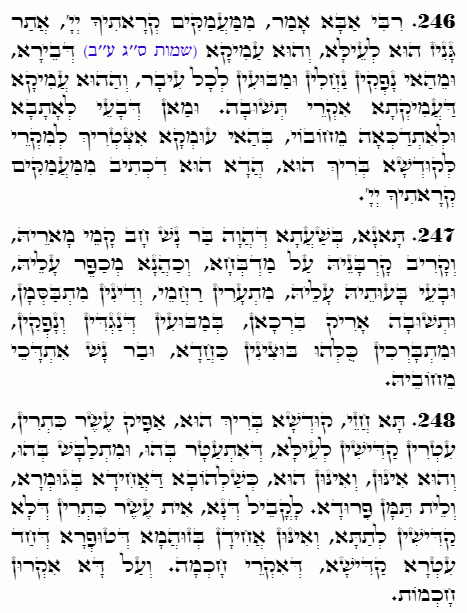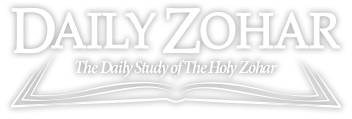Daily Zohar # 4658 – Acharei Mot – Why keep nails clean
Daily Zohar 4658

Hebrew translation:
247. לָמַדְנוּ, בְּשָׁעָה שֶׁהָיָה אָדָם חוֹטֵא לִפְנֵי רִבּוֹנוֹ וּמַקְרִיב קָרְבָּנוֹ עַל הַמִּזְבֵּחַ, וְהַכֹּהֵן מְכַפֵּר עָלָיו וּמְבַקֵּשׁ בַּקָּשָׁתוֹ עָלָיו, מִתְעוֹרְרִים רַחֲמִים, וְהַדִּינִים מִתְבַּשְּׂמִים, וְהַתְּשׁוּבָה מְרִיקָה בְרָכוֹת בְּמַעְיָנוֹת שֶׁשּׁוֹפְעִים וְיוֹצְאִים, וְכָל הַמְּאוֹרוֹת מִתְבָּרְכִים כְּאֶחָד, וְהָאָדָם נִטְהָר מֵחֶטְאוֹ.
248. בֹּא רְאֵה, הַקָּדוֹשׁ בָּרוּךְ הוּא הוֹצִיא עֲשָׂרָה כְתָרִים, עֲטָרוֹת קְדוֹשׁוֹת לְמַעְלָה, שֶׁהִתְעַטֵּר בָּהֶם וּמִתְלַבֵּשׁ בָּהֶם, וְהוּא זֶה הֵם, וְהֵם זֶה הוּא, כְּשַׁלְהֶבֶת הָאֲחוּזָה בְּגַחֶלֶת, וְאֵין שָׁם פֵּרוּד. כְּנֶגֶד זֶה יֵשׁ עֲשָׂרָה כְתָרִים שֶׁאֵינָם קְדוֹשִׁים לְמַטָּה, וְהֵם אֲחוּזִים בְּזֻהֲמַת הַצִּפֹּרֶן שֶׁל עֲטָרָה קְדוֹשָׁה שֶׁנִּקְרֵאת חָכְמָה, וְעַל כֵּן נִקְרְאוּ חָכְמוֹת.
.
Zohar Acharei Mot
Continued from previous DZ
#246
Rabbi Abba said: The verse “Out of the depths I have called to You, YHVH” refers to a hidden place above, which is the depth of the well, meaning Binah. From there, streams and springs flow in all directions, and this depth within the depth is called Teshuva. From this depth, whoever wishes to return and purify themselves from their sins must call upon the Holy One, Blessed be He. As it is written, “Out of the depths I have called to You, YHVH.”
#247
We have learned that when a person would sin before their Master, and they brought their offering to the altar, and the priest would atone for them and pray on their behalf, mercy would be aroused, and the judgments would be sweetened. The Teshuvah, which is Binah, would pour out blessings through the springs that flow forth, and all the lights, meaning the Sefirot of Malchut, would be blessed together, and the person would be purified from their sin.
#248
Come and see, the Holy One, Blessed Be He (Ein Sof), brought forth ten Sefirot, holy crowns above, in which He is adorned and clothed. He is them, and they are Him, “כְּשַׁלְהֶבֶת הָאֲחוּזָה בְּגַחֶלֶת” like a flame clinging to a coal, and there is no separation between Ein Sof and the Sefirot that clothe Him. Corresponding to this, there are ten Sefirot that are not holy, which are below. They are attached to the impurity of the “fingernails” of a sacred Sefira called Chokmah, which refers to Malchut, also known as the lower Chokmah. The backside light of Malchut is referred to as “fingernails,” and in the waste within them, called the impurity of the fingernails, the Klipot are attached. Therefore, they are also called “חָכְמוֹת” Chokmot (plural for Chokmah).
Notes:
The forces of impurity draw their sustenance from the “backside” of holiness, specifically from the least refined aspects of Malchut. The use of the term Chokmot reflects the way in which Chokmah of the impure level mimics or corrupts the pure Chokmah emanating from above. For this reason, we keep our nails clean at all times.
{||}

 Previous: Acharei Mot
Previous: Acharei Mot

